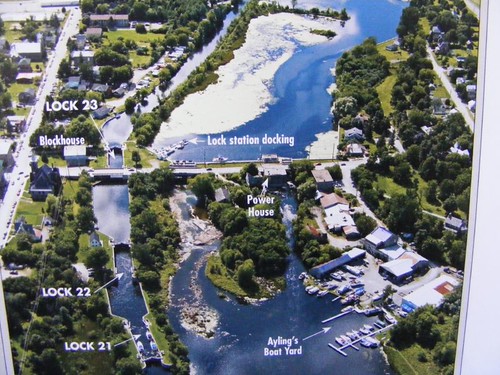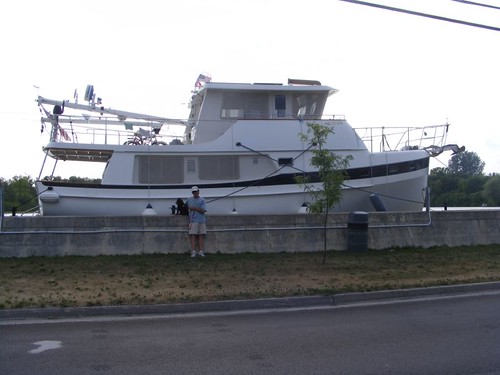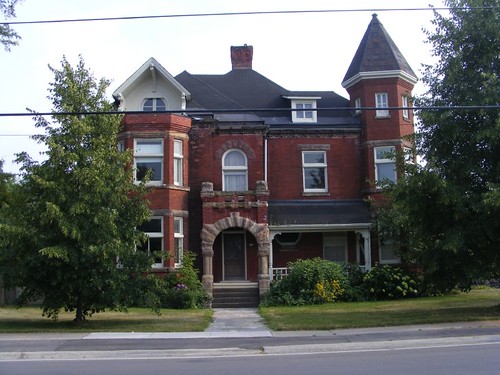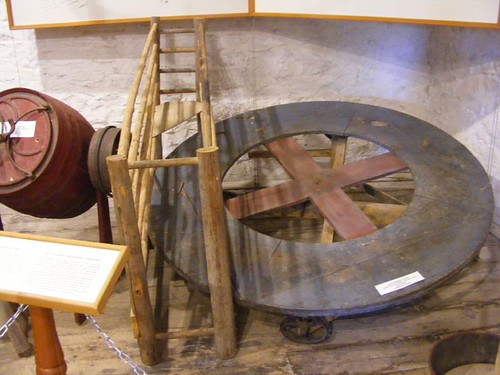August 5 – 6, 2011
Part 12 – Merrickville
Merrickville was named after William Merrick who arrived to the area in 1793. He recognized the enormous potential the falls in the area presented for industry and set up several milling operations. By the time the canal building began, 1826, Merrickville was a prosperous community. The citizens welcomed the idea of having the canal go through the area because they realized how it would make distribution of their goods much easier. Colonel By went out of his way to lay out the canal such that it would not affect the milling industries, unlike in several other towns, where he just bought out the mill owner and shut the mill down.
That “generosity” came back to bite him when William Merrick needed to fix one of his mill machines. He constructed his own dam to alter the water flow to aid in the repairs, and in so doing, cut the flow of water downstream for the canal system to an unnavigable level. Colonel By was furious, and told the government he needed to have full control over the water for the canal system or its operation couldn't be relied upon. The government agreed, and passed laws about water use that still apply today.
It was a good thing we timed our arrival to Merrickville (7.5 miles from Kilmarnock) for early in the morning because by noon all the dock space was filled up. We knew that those 4 French boats we had met at Poonamalie were headed this way, so we wanted to make sure we were ahead of them.
The lockmaster was expecting us, and told us to tie up to the wall where you can see one boat in the above photo, under the “lock station docking” text. That area is known as The Pond. One sign behind us said “Danger”, and the other sign in front of us said “Extreme Danger”. That gave us a comfortable feeling!
This photo shows how weird it is for the motorists to see boats above the level of the road. Since we are so high, the effect is intensified.
Notice that each of the locks has a basin associated with it, so they are 3 individual locks. Lock 23 has to operate in conjunction with a bridge, which was having some operational problems when we were there. The left side of the approach into Lock 23 is also a campground; the sites are really nice since it is quiet, and campers can easily watch all the boats go by.
Part of the original river bed and rapids still remain and are visible in the photo to the right of the strip of green space located to the right of Locks 21 and 22. You can see how rocky the river bed is, some areas having solid sheets of hard rock especially visible now since the water level is so low. An organization called Friends of the Rideau has created a waterfront trail that takes you from their headquarters, called The Depot, above Lock 23, all the way around to the entrance to The Pond, next to the lock cut. Pick up a descriptive brochure for your walk from The Depot.
The little town is very charming. There are plenty of restaurants, clothing boutiques (I think a lot of the French Canadians shop here for their line handling outfits!), gift and artisan shops, and importantly, ice cream vendors. It is worth the time to walk all the way to the opposite end of the street to the glass blower's gallery. He actively works on his treasures out in the open and willingly answers questions between the different melting stages. His creations are truly works of art, not cheesy trinkets. Eddie purchased a Witch Ball, purported to ward off bad spirits and create peace and harmony. We certainly need that for FLUKE, but since he can't figure out where to safely hang it, it is not performing its magic yet.
We ate at the Goose & Gridiron because when we were at Poonamalie the French people told us it had the best fish & chips in Canada. The fish was great, but the chips were just mediocre.
Eddie and I browsed many of the shops during the town event called “The Inside Out Sale”. We bought a bat house, made in Canada. We had been trying to find a bat house for a while and were happy to finally get one.
Wayne and I took a couple of our requisite neighborhood walks. The Merrickville & District Historical Society (MDHS) publishes a walking style brochure. This style is called Richardsonian-Romanesque. Roger Percival was a foundry owner who must have had a good business to build a home this opulent. Notice the entry arch for the old coaches.
Because Merrickville was the most prosperous town between Ottawa and Kingston, Colonel By felt it would be a logical target if an invasion by the Americans was to occur. So, he built a defensible blockhouse, the second largest in Canada. You can see that it is right next to Lock 23 in the overview photo. Today, the MDHS manages the blockhouse as a museum. There are a lot of canal artifacts, canal period lifestyle memorabilia, and even an original one room schoolhouse. Most of the items have been donated by residents.
This thing really fascinated me since I am such a dog lover. You can see where the dog would be placed, and by walking, would make the wheel turn to run a churn or grinder. This was the first time I'd ever seen a dog-powered piece of equipment like this.
Merrickville merits a stop, whether traveling on the waterway or roadway. You won't be disappointed.
Tuesday, August 30, 2011
Subscribe to:
Post Comments (Atom)














Please post a picture of your (soon to be?) new line handling outfit. (You know you want one. ;) Thanks!
ReplyDeletehandymanalex